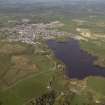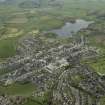Carlingwark Loch
Crannog(S) (Period Unassigned), Logboat(S)
Site Name Carlingwark Loch
Classification Crannog(S) (Period Unassigned), Logboat(S)
Alternative Name(s) Ash Island; Fir Island
Canmore ID 64674
Site Number NX76SE 8
NGR NX 7600 6100
NGR Description NX c. 7600 6100
Datum OSGB36 - NGR
Permalink http://canmore.org.uk/site/64674
- Council Dumfries And Galloway
- Parish Kelton
- Former Region Dumfries And Galloway
- Former District Stewartry
- Former County Kirkcudbrightshire
NX76SE 8 c. 7600 6100
For possible fortified island (Fir Island, at NX 7629 6093, see NX76SE 9. For bronze swords and other metalwork found in and around the loch, see NX76SE 11, NX76SE 12, NX76SE 13.
(NX 7629 6107) Ash Island (NAT) Site of Lake Dwelling (NR)
OS 6" map (1946)
In Carlingwark Loch there were four fortified islands, two of them artificially constructed of oak piles. A bronze cauldron (NX76SE 13), a bronze sword (NX76SE 12), canoes and a bronze pan have also been found.
J Stuart 1875
Two artificial islands were found when the loch was drained in 1765. At the same time two dugout canoes, a dam, to maintain the level of the water in the loch, and a planking floor were found.
OSA 1794 (T Halliday); R C Reid 1946
Ash Island is of an artificial nature.
RCAHMS 1914
At the time of field investigation Ash Island was largely submerged by the high level of the loch and from the nearest point on the shore of Fir Island it was not possible to discern any artificial features, only the trees and a very little ground being visible.
Visited by OS (RDL) 13 February 1963.
The Statistical Account notes the discovery at 'several places' in Carlingwark Loch of 'canoes' which had been 'hollowed...with fire'. The loch is situated in pastoral drumlin country at an altitude of about 45m OD and the boats were probably found either in 1765 when the size of the loch was greatly reduced by the construction of a drainage-canal, or in the following years when much of the lake-bed sediment was taken for agricultural marl. Their fate is not recorded.
Other antiquities found in the loch include Iron Age and Romano-British metalwork and at least one crannog, but there is no evidence to support the 'Celtic' attribution of the boats that Affleck proposes.
In view of the experimental evidence for the ineffectiveness of fire in working large oak timbers these boats may have worked from softwood or (more probably) fire-working may have been suggested on the basis of the mis-interpretation of incipient rot.
Stat. Acct. 1791-9; D Wilson 1851; J Affleck 1912; R C Reid 1944; M MacGregor 1976; R J C Mowat 1996; Information from Mr D Goodburn.
























